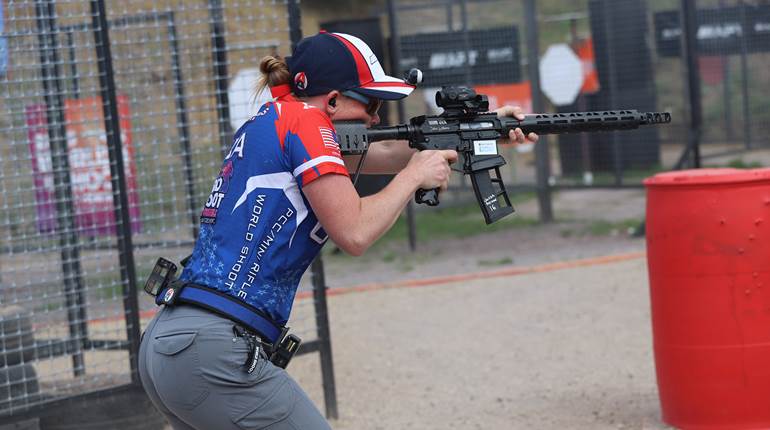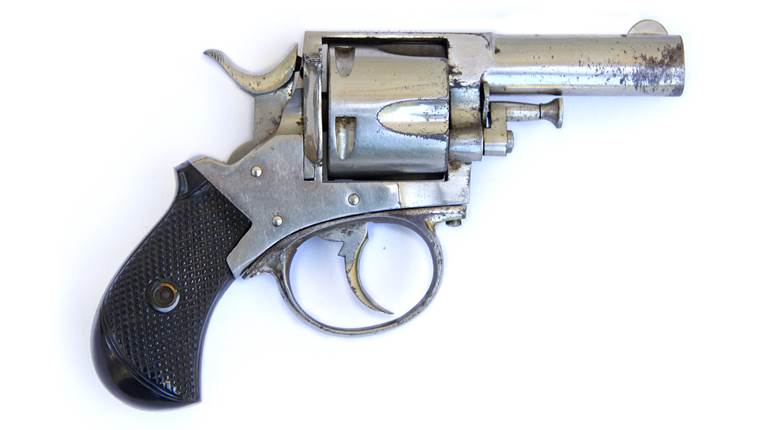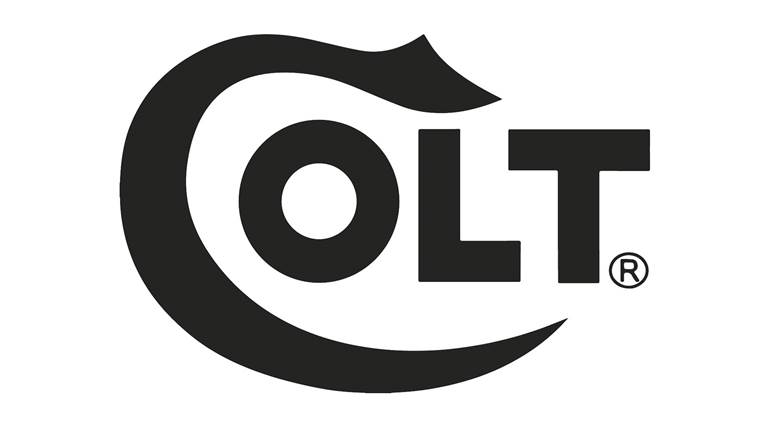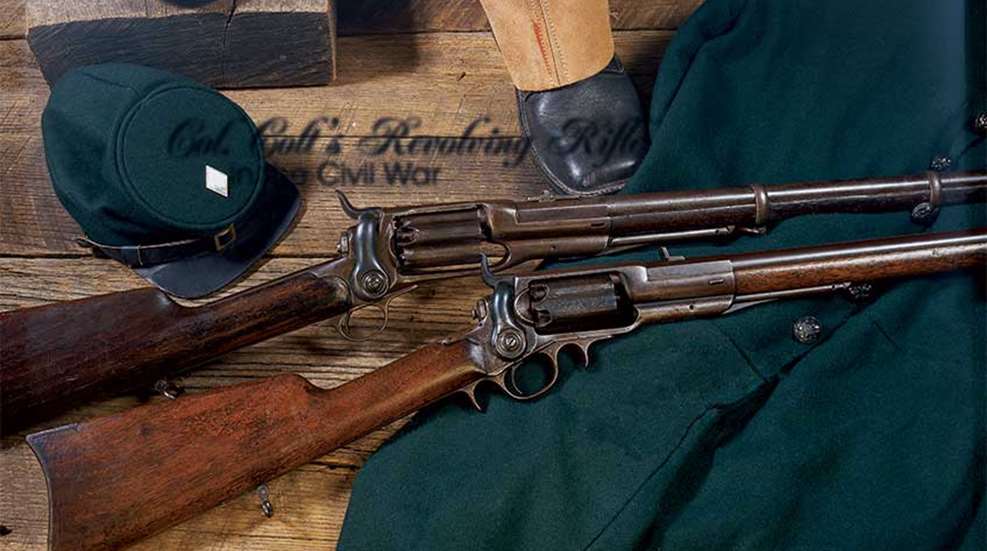
This article, "Col. Colt's Revolving Rifle in the Civil War," appeared originally in the March 2004 issue of American Rifleman. To subscribe to the magazine, visit the NRA membership page here and select American Rifleman as your member magazine. Above: Two basic patterns of the Model 1855 Colt revolving rifle were acquired by the U.S. government. The wartime procured rifles were generally five-shot .56 calibers, while the pre-Civil War rifles were six-shooters in .44 caliber.
Before the start of the American Civil War in 1861, the U.S. Army had acquired relatively few breechloading rifles as the .58-cal. muzzleloading rifle-musket was the standard arm of the infantry, while the Sharps carbine was the major arm of the cavalry. There were only two breechloading designs in U.S. arsenals before the war, the obsolete Hall and the Colt Model 1855 revolving rifle.
First manufactured in 1856, the side-hammer, cap-and-ball Colt Model 1855 rifle operated on similar principles to Col. Samuel Colt’s revolving handguns. In 1857, 100 Colt rifles were purchased and sent to the U.S. troops for field service. The pre-war .44-cal. rifles were six-shot repeaters, while the wartime-procurement guns were .56-cal. five-shots.
The barrel length of the U.S. Army Colt rifles ranged from 31 5⁄16” to 37 1⁄2”, and the full-length fore-end was attached to the barrel by two-barrel bands. The rear sight was graduated up to 600 yds., and the topstraps of the .56-cal., wartime-made guns were stamped, “COL. COLT HARTFORD CT. U.S.A.” The cylinders were fluted, and the rifle took either the angular or saber bayonet. Prior to 1861, the Army had taken delivery of more than 700 Model 1855 Colts.
Civil War Field Service 1861-1862
In May 1861, a company of the 8th Massachusetts Infantry was issued Colt revolving rifles while serving in and around Washington, D.C. Later in 1861, pickets of the 12th Kentucky Infantry skirmished with Confederate cavalry at Mill Springs, Ky. The pickets, armed with Colt rifles, killed four rebels with eight shots at 300 yds.
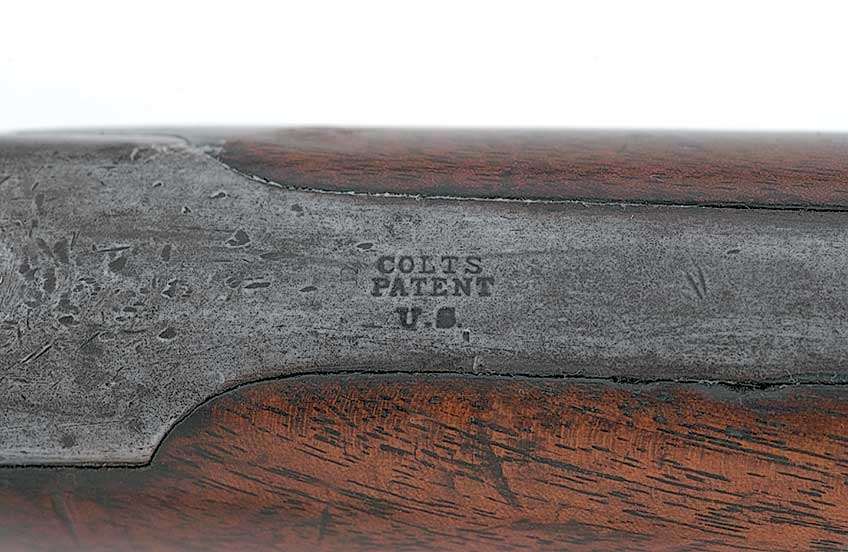
At the end of January 1862, Washington Arsenal took delivery of 1,000 .56-cal. Colt Model 1855 revolving rifles with 37 1⁄2” barrels, and they were issued to Berdan’s 1st and 2nd U.S. Sharpshooters (U.S.S.S.). When the sharpshooters were informed of the matter, the men rioted. They had been promised Sharps target rifles, and they wanted the Sharps—no other arm would do. Berdan had to place a guard around his headquarters until the excitement subsided.
One man of the 2nd Sharpshooters was so dissatisfied, he marched off to war with a Springfield rifle-musket. The sharpshooters left for the front with the Colts and some individual target rifles. The 1st U.S.S.S. used its Colts in the Siege at Yorktown against Rebel artillery batteries, while the 2nd U.S.S.S. fought against Confederate infantry and artillery at Falmouth, Va. The Colts were exchanged for the promised Sharps by early June, and, in August 1862, the Washington Arsenal had 445 of Berdan’s Colts in storage.
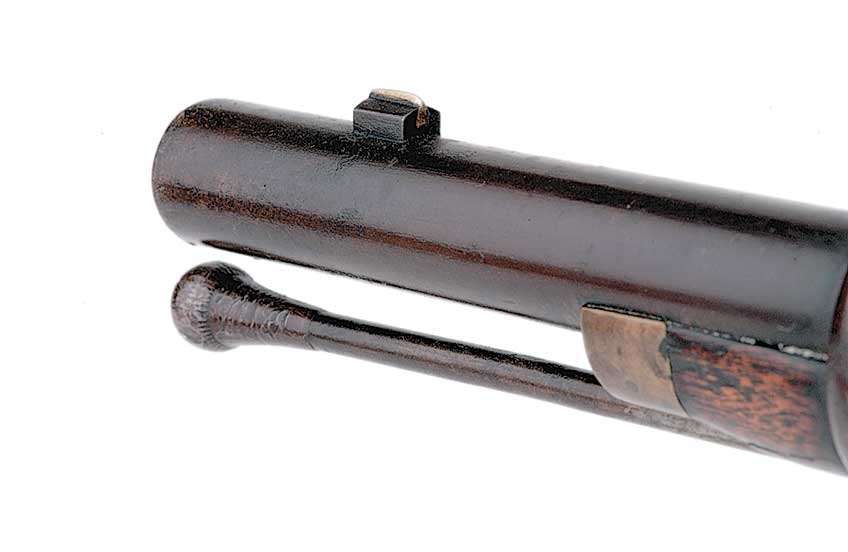
Model 1855 Colt revolving rifles went mostly to Union cavalry in 1862, including the 2nd Michigan Cavalry commanded by Col. Phillip H. Sheridan. On July 1, 1862, near Booneville, Miss., the 2nd Michigan’s pickets were attacked by Confederate cavalry led by Brig. Gen. James R. Chalmers. In the fight, Sheridan used his 160 cavalrymen with their revolving rifles to hold the advance of Chalmers’ cavalry while he attacked them in the rear and on the left flank. This forced the Confederates to retreat. The Yankee riflemen waited until the charging Southerners were within 25 to 30 yds. before opening up with their Colts, and the U.S. cavalrymen were pressed so close that they were forced to use the butts of their Colts in hand-to-hand encounters to beat back the attack.
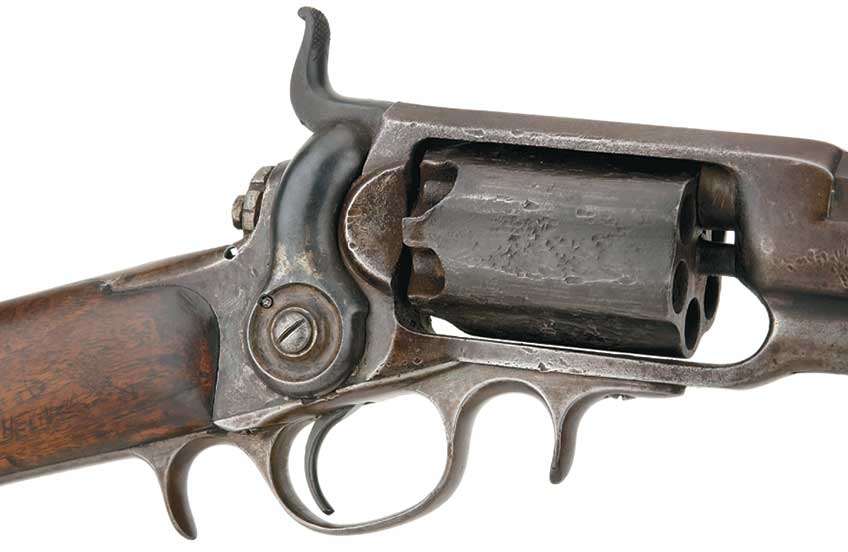
A second cavalry regiment in the Booneville action was the 2nd Iowa. It is not likely that it was issued Colts in this battle, but by December, it listed 333 Colt rifles. The 2nd Iowa was part of the advance cavalry forced attacked near Coffeeville, Miss., on December 5, and it dismounted the four companies armed with Colts and kept its two saber companies mounted. When the attackers came within 20 yds., the men volley fired with their Colts, and the cavalrymen fired three rounds before they were outflanked and were forced to retreat to a second defensive position and repeat the process. They were again outflanked and had to retreat to a third position when night ended the battle. The number of casualties was not stated, but the rifle companies with Colts suffered five of its seven officers wounded.
Maj. Gen. William S. Rosecrans, commanding the Union forces around Corinth, Miss., was greatly concerned about the lack of small arms for his cavalry. To totally arm three of his regiments, he requested 824 Colt revolving rifles, and on October 28, 1862, the Colt factory delivered 824 to the Army. The Colts sent to Rosecrans’ units were issued as follows: 294 to the 3rd Michigan Cavalry, 30 to the 2nd Iowa; and 500 to 7th Kansas. A month later, the Ordnance Department ordered 1,600 more Colt revolving rifles for Rosecrans’ cavalry.
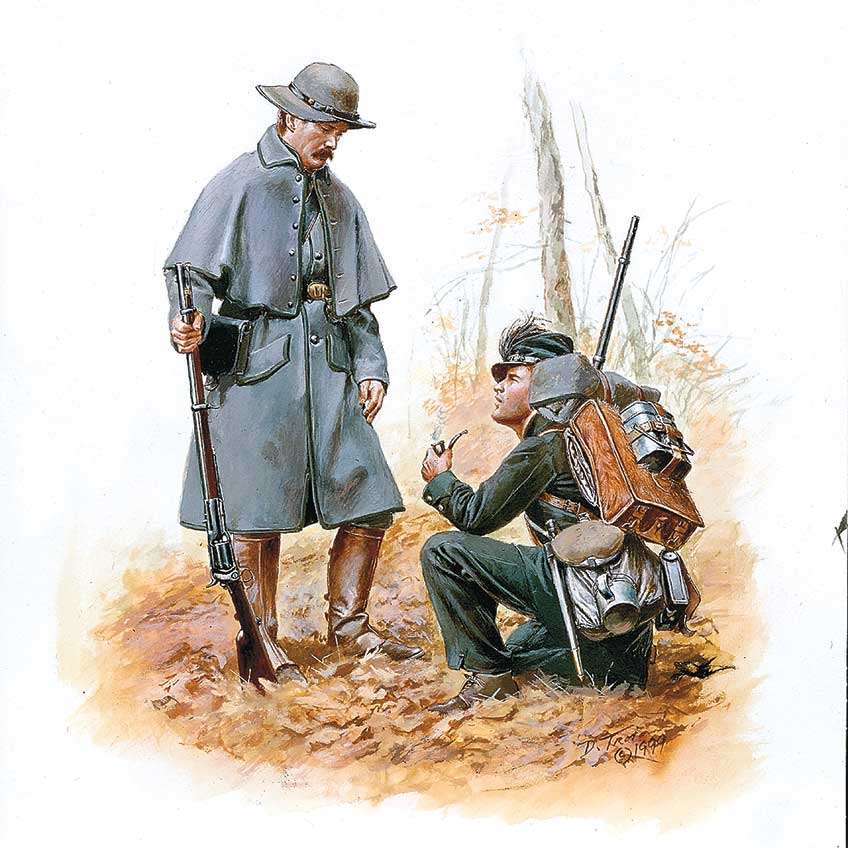
On the last day of the year, one company of the 2nd Indiana Cavalry was on courier duty between Nashville and LaGrange, Tenn. At 3 p.m., they were attacked by Rebel cavalry with one lieutenant and 13 men captured. In addition to the 14 men taken prisoner, the Confederates seized 15 horses, 10 mules, two wagons with company property, 15 Colt revolvers and 11 Colt revolving rifles. At the end of the year, only 13 regiments reported Colt revolving rifles in inventory for a total of about 2,400 rifles.
Field Service 1863
One of the largest issues of Colt revolving rifles in 1863 went to the 21st Ohio Infantry. On May 28, 1863, the regiment turned in its 350 Enfield rifle-muskets for a like quantity of .56-cal., five-shot Colts. The 21st’s rifles had been previously issued to Berdan’s Sharpshooters and were equipped with 37 1⁄2” barrels. These “hand-me-down” rifles played a major role in the 21st’s part in the stubborn Union defense at Chickamauga on September 20. The 21st went into battle with 22 officers and 517 men, and 347 were armed with Colts and 170 with Enfields.

At about noon, shortly after they broke through the Union lines, Maj. Gen. James Longstreet’s infantry struck the 21st Ohio but was driven back. The Confederates skirmished with the 21st, and, at 2 p.m., a second attack was again forced back. After that, a lack of ammunition started to become a major concern. The cartridge boxes of the dead and wounded—as well as those in the nearby hospital—were scoured for additional ammunition. At 5 p.m. a third attack came within 20 yds. of success before it, too, was repulsed.
The 21st was now down to only one round per man with no hope of re-supply. It was relieved by the 2nd Minnesota Infantry and sent to the right of the Union lines. At dark, the 21st was attacked by four Confederate infantry regiments and had to surrender because the men were totally out of ammunition. In the battle, the 21st lost 167 of its Colts, and its casualties were 28 killed, 84 wounded and 131 captured. The 21st had expended 43,550 rounds—or about 85 rounds per man. At the end of the battle, the 21st Ohio inventory of small arms by company was as follows:
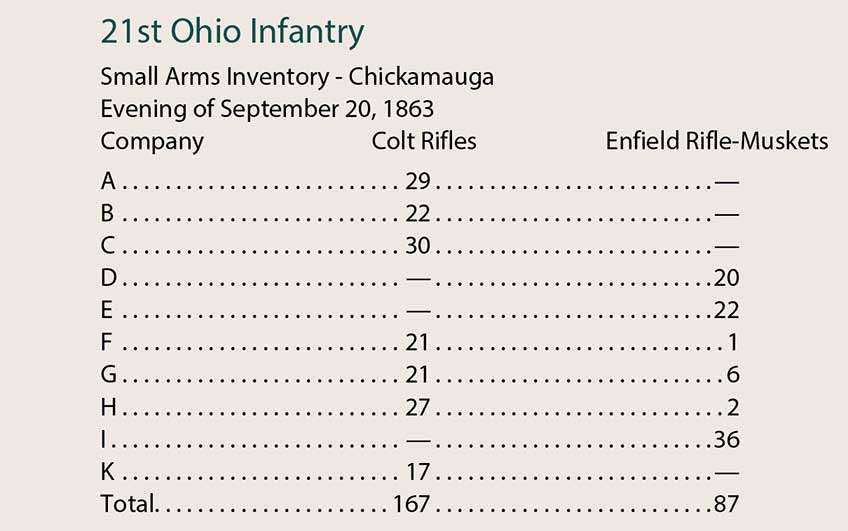
Brig. Gen. Sheridan commanded the 3rd Division, 20th Army Corps, at Chickamauga, and four of Sheridan’s infantry regiments—22nd and 51st Illinois, 15th Missouri and the 21st Michigan—were partially armed with Colt revolving rifles. The 21st Michigan was near Rosecrans’ Headquarters at the Widow Glen’s house at the time of Longstreet’s breakthrough. The men were moved about 400 yds. from the house and became the extreme right of the Union lines.
The men of Company A, armed with Colt revolving rifles, were placed on the right flank to protect it. The enemy made two attempts to get around them and were successful on their second try. Company A held the line for over an hour before being outflanked and forced back. A few days after the battle, the four regiments listed the following quantities of Colt rifles on hand: 21st Michigan, 17; 15th Missouri, 44; 22nd Illinois, 7; and the 51st Illinois, 5.
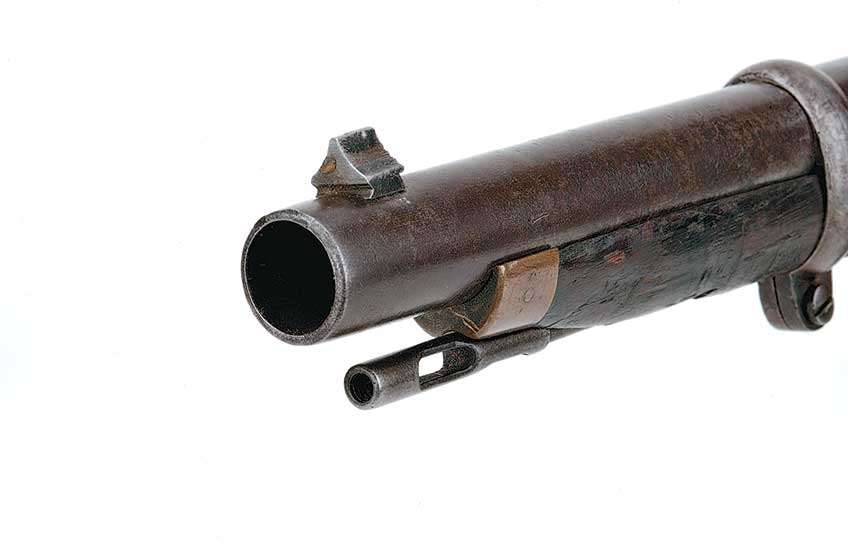
During that period, several reports were received from the field on the effectiveness of the various small arms in the hands of the troops. Col. Thomas B. Herrick of the 7th Kansas Cavalry felt the Colt rifle was very delicate and liable to get out of repair from the manner of carrying it slung over a cavalryman’s shoulder. At the time, December 1863, the 7th had 198 Colt rifles. Maj. S.C. Scranton’s 2nd Michigan Cavalry had 271 Colt rifles in November, and he also believed the Colt was a frail arm. The 2nd Indiana Cavalry had one company armed with 27 Colt rifles, and the 2nd’s Maj. David A. Briggs stated, “I would respectfully support that although the Colt rifles are a very good arm in time of action, they are difficult to keep in order specially [sic] during rainy weather.”
In the fall of 1863, the U.S. Army had more than 2,700 Colt rifles in service, with 700 in infantry regiments. The largest numbers were in the 21st Ohio, 166; 37th Illinois, 67; 12th Kentucky, 58; 26th Kentucky, 119; 34th Kentucky, 57; 2nd Minnesota, 13; 15th Missouri, 44; 21 Michigan, 17; and 7th U.S. Regulars, 14. The cavalry had more than 2,000 Colt rifles with the largest numbers in the following: the 1st Colorado, 143; 9th Illinois, 142; 2nd Iowa, 302; 7th Kansas, 83; 2nd Ohio, 93; 2nd Michigan, 266; 3rd Michigan, 382; 4th Michigan, 155; 1st Missouri, 399; and 3rd Missouri State Militia Cavalry, 61.
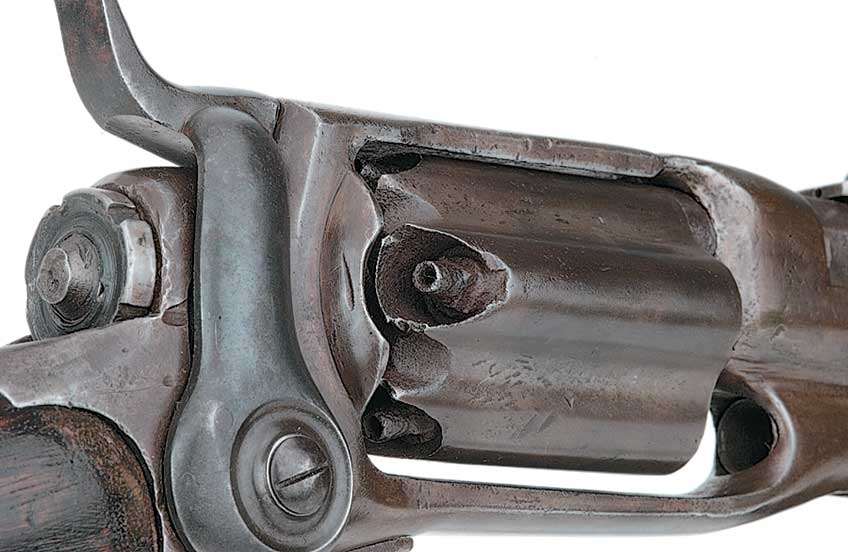
Field Service 1864-1865
During the early days of 1864, many Union regiments re-enlisted and were given veteran furloughs. They would turn in their arms before going on leave and often, upon returning, be issued different ones. In this manner, cavalry regiments, such as the 2nd and 3rd Michigan, were issued Spencer carbines (2nd) and Starr carbines (for the 3rd) to replace their Colt rifles. One cavalry regiment mainly armed with the Colt revolving rifles (357) during the first half of the year was the 9th Illinois Cavalry. The 9th had received its Colt rifles in April 1863. The historian of the 9th states that the Colt was a very effective arm but did have one serious drawback. When the rifle was being discharged, it would shoot splinters of lead into the left wrist and hand of the person firing it.
At Brice’s Crossroads, Miss., on June 10, 1864, the Union cavalry and infantry were soundly defeated by Forrest’s Confederate forces. A force of 140 men from the 9th Illinois Cavalry armed with Colt revolving rifles was used as advanced skirmishers placed behind logs and trees. On the third attack by Forrest’s men, and after hand-to-hand fighting, the Union cavalry line was forced to give way.
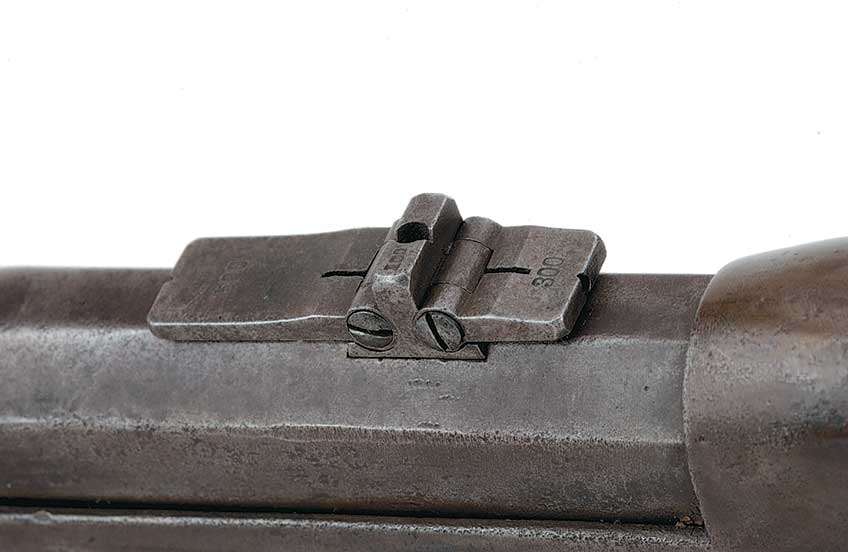
The infantry, being several miles behind the cavalry, came up as the cavalry was being forced back, and was able to hold the line for a short time before they, too, gave way. Over the next two days, in the rain and mud, the 9th Illinois was used to cover the retreating column’s rear. They would take up a position, hold it as long as possible and then fall back to a new position and then repeat the process all over again. The Union suffered more than 2,200 casualties, of which 1,600 were prisoners.
The 21st Ohio, which had so gallantly fought at Chickamauga, was directed to turn in its Colts for Enfields of Springfields. By summer, the 21st Ohio had no Colt rifles. By June 1864, the number of Colt revolving rifles listed in field service had decreased to about 1,300 rifles.
In Maj. Gen. William T. Sherman’s Atlanta Campaign from May 4 to September 8, 1864, five regiments listed a few Colt rifles. In the Army of the Cumberland commanded by George Thomas, the 3rd and 7th Kentucky Cavalries and the 42nd and 73rd Illinois Infantries were armed with a combined total of about 100 Colt rifles. During the campaign, the Army of the Cumberland expended 10,760 Colt rifle cartridges.
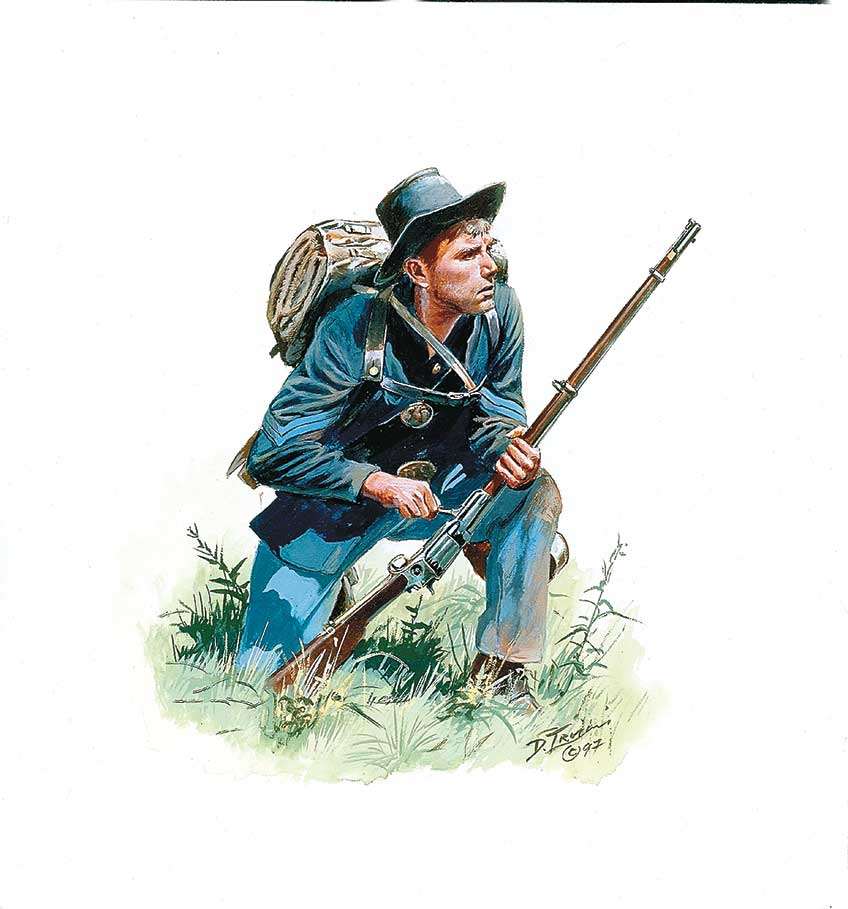
The Army of Ohio, led by John Schofield, expended 5,000 Colt cartridges during the campaign. In June, the 12th Kentucky Infantry of Schofield’s command had 112 Colt rifles, plus Springfield rifle-muskets. In Sherman’s march to capture Atlanta, between May 4 and September 8, 1864, the 200 Colt rifles in the two commands (Thomas’ and Schofield’s) fired only 15,760 Colt rifle cartridges.
The 3rd Massachusetts Heavy Artillery was formed in August 1864 for duty in the nation’s capital. The unit was part of the force that reinforced the Washington defenses, performed garrison duty north of the Potomac River, and was issued 120 Colt revolving rifles, plus Springfield rifle-muskets. One cavalry regiment with Colt rifles in early 1865 was the 1st Mississippi (U.S.) Mounted Rifles. The Mounted Rifles was part of Grierson’s Raid against the Mobile and Ohio Railroad in January 1865. After returning from the raid, Capt. C. Bowman stated that all 168 Colt rifles of the 1st Mississippi Mounted Rifles were unserviceable, and the Colts were turned in for Sharps carbines.
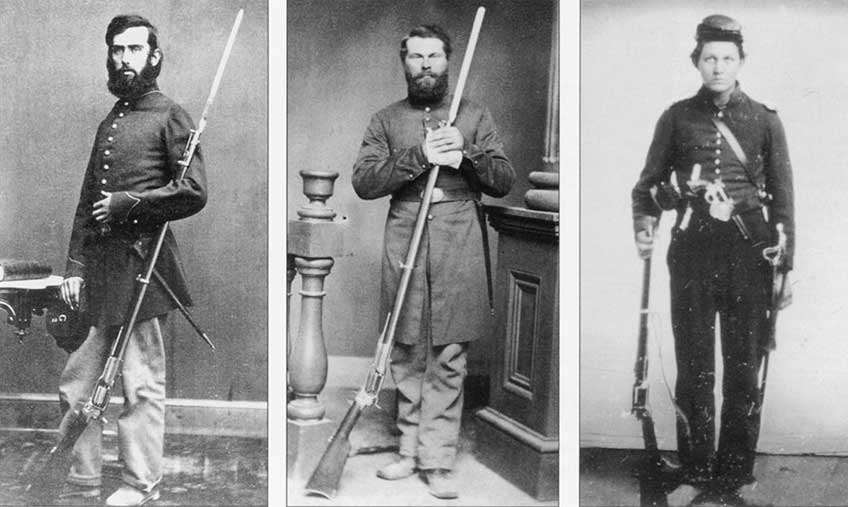
At war’s end, 305 Colt rifles were taken home. In the period after the war, they were sent into storage, since their useful military life had come to an end. As of May 1866, the St. Louis Arsenal reflected 105 serviceable Colt rifles on hand, plus an additional 885 rifles in need of repair—an ignominious end for a rifle that saw service from the beginning to the end of the Civil War.












